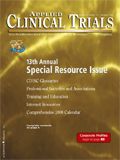EU Agencies Update
Along with the titles and phone numbers of personnel, View from Brussels columnist Peter O'Donnell gives an update on the regulatory front in Europe.
At the start of 2007, the European Union grew again to 27 member states, with the accession of Bulgaria and Romania boosting the EU's patient population to nearly 500 million. And European regulatory affairs have continued to become more complex.
In part this is a result of the rapid growth of the EU itself—with a total of 12 member states still trying to master the requirements they have had to take on board since they joined.

But it is equally a consequence of developments in technology and in health care. This year has been marked by uncomfortable reminders of the risks as well as the benefits of new medicines. Regulators have struggled to get a satisfactory grip on first-in-man trials in the wake of the disastrous Tegenero trial in 2006. There has been new emphasis on pharmacovigilance and on patient information. And clinical trial rules have come in for criticism for making medicines development more difficult while putting patients at greater risk.
The European Medicines Agency issued draft guideline on first-in-man clinical trials for potential high-risk medicinal products, then held a workshop in June to flesh out its guidance on managing the transition from nonclinical studies to first tests in humans. But divergences remained over the classification of high-risk versus nonhigh-risk medicinal products, and final guidance has still to emerge.
In February, the EU announced a strengthening of its pharmacovigilance system, with better implementation and proposals to tighten up the legal framework. And the EU con ducted a public consultation in the spring on the way information about medicines is provided to patients; the outcome is likely to be further safety-related rules.
Meanwhile, a major conference at the European Medicines Agency in October revealed widespread discontent with the EU rules on clinical trials among industry and academia—but little enthusiasm among authorities to make any significant amendments.

EMEA Board
The second meeting of the EU's annual pharmaceutical forum in June did even less to inspire confidence among industry than its predecessor in 2006. Although this high-level group of ministers from the member states is intended to improve conditions for research and development in Europe, industry fears that it will create more regulation without any compensating advantages.
On the brighter side, at the end of October the EU formally adopted its new regulation, making it easier to obtain market access across all 27 member states for advanced therapy medicines. The new rule will come into force at the end of 2008.
The EU has launched a broad public debate on the future of pharmaceuticals for human use as a prelude to proposing a new vision for a real single market to replace the current patchwork quilt of national regulations on medicines.
The European Medicines Agency's new Pediatric Committee was set up in September, as the new regulation came into force. It is now starting its work on identifying priority areas of need and on recommending rewards for promising clinical trial projects for medicines for children. The EU also opened a consultation on the functioning of its orphan drug rules to assess how well the period of market exclusivity is acting as an incentive to innovation in treatments for rare diseases.
And the volume of marketing authorization applications through the EU's centralized procedure continues to grow. By the end of October, 70 applications had been received during 2007, leading to positive opinions on 50 and negative opinions on three. The EU had finalized marketing authorizations for 46—bringing to 411 the total of products authorized through this procedure since it was set up in 1995.
Peter O'Donnell, View from Brussels columnist, is a freelance journalist who specializes in European health affairs. He is based in Brussels, Belgium.
FDA Fast Tracks Johnson & Johnson’s Nipocalimab for Fetal Neonatal Alloimmune Thrombocytopenia
March 27th 2024Johnson & Johnson is moving forward with a pair of Phase III trials of nipocalimab to reduce the risk of fetal neonatal alloimmune thrombocytopenia in alloimmunized pregnant patients.
